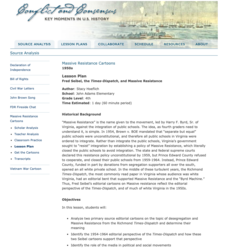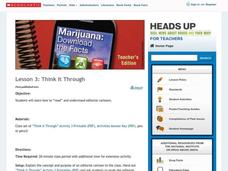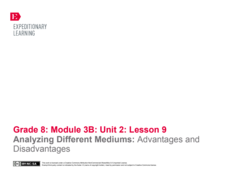Roy Rosenzweig Center for History and New Media
Fred Seibel, the Times-Dispatch, and Massive Resistance
A lesson challenges scholars to analyze editorial cartoons created by Fred Seibel, illustrator for the Times-Dispatch, during the Massive Resistance. A class discussion looking at today's editorial pages and Jim Crow Laws leads the...
Curated OER
Exploring Media: Understanding and Identifying Editorial Perspective in Television and Radio News
Students research the topics Boat People: A Refugee Crisis, Dr. Henry Morgentaler: Fighting Canada's Abortion Laws, and CANDU: The Canadian Nuclear Reactor on the CBC Radio and Television Archives Web site.
Scholastic
Think it Through
What does the media tell the teenagers about using marijuana? Help class members decipher what they are being told about drug use with a lesson on editorial cartoons, subliminal messages, and critical thinking skills.
PBS
The Media and the War: The Penny Press, Walt Whitman and the War
The Mexican-American war marked a significant moment in United States history, as well as in the history of American media. The mid-nineteenth century saw the introduction of the Penny Press, which provided many American citizens with...
Curated OER
Drawing Political Cartoons
Students draw political cartoons. In this editorial cartoons lesson, students discover the history of the cartoons in America, analyze some cartoons, and then draw their own cartoons that make social statements.
Media Smarts
You Be the Editor
Look at different case studies to discuss the ethics of journalism. Twelve real-life events are written up and your learners get to be the editors. Encourage your class to think about the implications of publishing decisions. After each...
Curated OER
Confederation Editorials
Learners investigate what an editorial is and will write one, for their simulated newspaper, about Confederation using primary-source documents from the "EvidenceWeb" portion of the Learning Centre, on the Library and Archives Canada...
The New York Times
I Don’t Think So: Writing Effective Counterarguments
When it comes to writing effective arguments, writers must do more than simply make a claim, counterarguments must be considered. Aspiring writers analyze counterarguments in editorials, and then learn how to write counterarguments in...
Curated OER
Cartoons for the Classroom: The Economic Paradox
It's a classic conundrum of economics: voters want jobs, but don't want to spend the money required for businesses to hire. This political cartoon analysis worksheet has learners analyzing this enigma and responding to 3 talking points...
Curated OER
Cartoons for the Classroom: College as Concept
In this current events learning exercise, students analyze a political cartoon about the college application process and respond to 3 talking point questions.
Curated OER
Cartoons for the Classroom: Why is Freedom of Speech a Burning Issue?
In this current events worksheet, students analyze a political cartoon about the freedom of speech and respond to three short answer questions
Curated OER
Cartoons for the Classroom: Timely vs. Timeless
In this historical events worksheet, students analyze a political cartoon about bank failure and respond to 2 talking point questions.
Curated OER
Immigration
This 3-day immigration study draws on historical trends and current events. A worksheet accompanies initial research on one group's U.S. immigration history, giving opportunity for collaborative learning through sharing findings. Groups...
Curated OER
Cartoons for the Classroom: 9/11 Revisited
Political cartoons about the September 11 terrorist attacks provide an opportunity for class members to analyze the inferences embedded in the drawings.
EngageNY
Group Discussions and Revision: Editorial Essay
Great minds think aloud! Pupils participate in the Fishbowl protocol, discussing their opinions about the Mary River mine proposal. As they share their thoughts, peers provide feedback about their thesis and supporting ideas.
EngageNY
Analyzing Different Mediums: Advantages and Disadvantages
How do authors play to people's moods? After briefly reviewing mood using a Conditional and Subjunctive Mood handout, learners practice identifying conditional and subjunctive sentences in the Montgomery Bus Boycott speech before reading...
Curated OER
Fact vs. Opinion (Part II)
How can you tell the difference between fact and opinion? Using newspapers, learners determine which articles contain statements of fact, and which articles reflect the writer's opinion. The lesson plan includes a discussion format and a...
Curated OER
Re-Viewpoints From 2002
Students explore how editorials use various devices to convey a message to a reader. They select key news topics from 2002 and write their own editorials.
Curated OER
Propaganda Flyer
Fourth graders create a persuasive flyer to sway the opinion of the class on a controversial issue. They read assigned editorials representing the viewpoint that they must defend.
Curated OER
Journal Assignment Directions
In this journalism analysis activity, students choose and editorial article and analyze the content. Students will write articles with a minimum of 350 words.
Curated OER
Propaganda Techniques
Sixth graders locate examples of persuasive writing. For this persuasive writing lesson students work in a groups to identify and analyze the use of propaganda techniques. Students use newspapers to find editorials, or advertisements,...
Curated OER
Cell Phones with Cameras Banned in Locker Rooms
Students research the way phones work and what places - both locally and nationally - have already faced the problem of in appropriate use. Students also interview gym owners or managers in their community and those who use they gyms....
Curated OER
The assassination of the Archduke: Exploring Perspectives
Use political cartoons for a multiple-perspectives strategy, as pupils learn about the assassination of Archduke Franz Ferdinand. After an anticipatory discussion, they are split into 2 groups. The class reads a primary source account...
Curated OER
Newspaper Unit: Reading Lesson Plan
Work on identifying the different parts of a newspaper with your English learners. After reviewing newspaper terminology, pupils pair up and complete a scavenger hunt, looking for specific things in the newspaper and recording their...

























